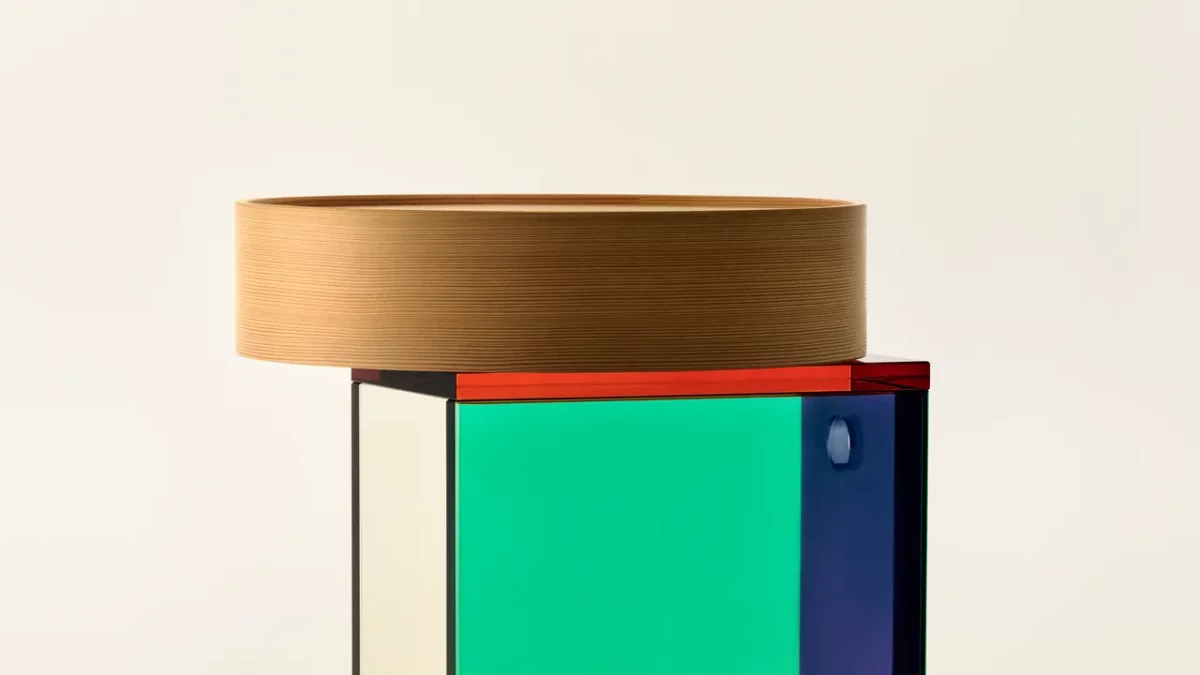You love Design History ? You will love to discover how the iconic Parisian saddlery Hermès became one of the most sought-after names in contemporary design.
Imagine this: you’re wandering the halls of Milan Design Week 2025, and suddenly you freeze in awe. Suspended white cubes float in space, casting vibrant halos of color across a pristine floor. The objects inside appear to dance in this magical light. You’ve just stepped into Hermès’ furniture universe — and believe me, this is only the beginning of a fascinating story.
Yes, Hermès makes furniture. And not just any furniture! Behind this seemingly obvious fact lies one of the most spectacular transformations in the world of contemporary luxury. How did a company founded in 1837 to outfit Parisian carriages become the creator of some of the most coveted furniture pieces in the world?
Once Upon a Time… Hermès and Design (Spoiler: It Begins in the Roaring Twenties!)
When Jean-Michel Frank Discovered Hermès Saddlery: A Creative Love Affair
Our story begins in the vibrant Paris of the 1920s. The Roaring Twenties are in full swing, Art Deco is revolutionizing aesthetics, and a visionary decorator named Jean-Michel Frank walks into the house of Hermès.
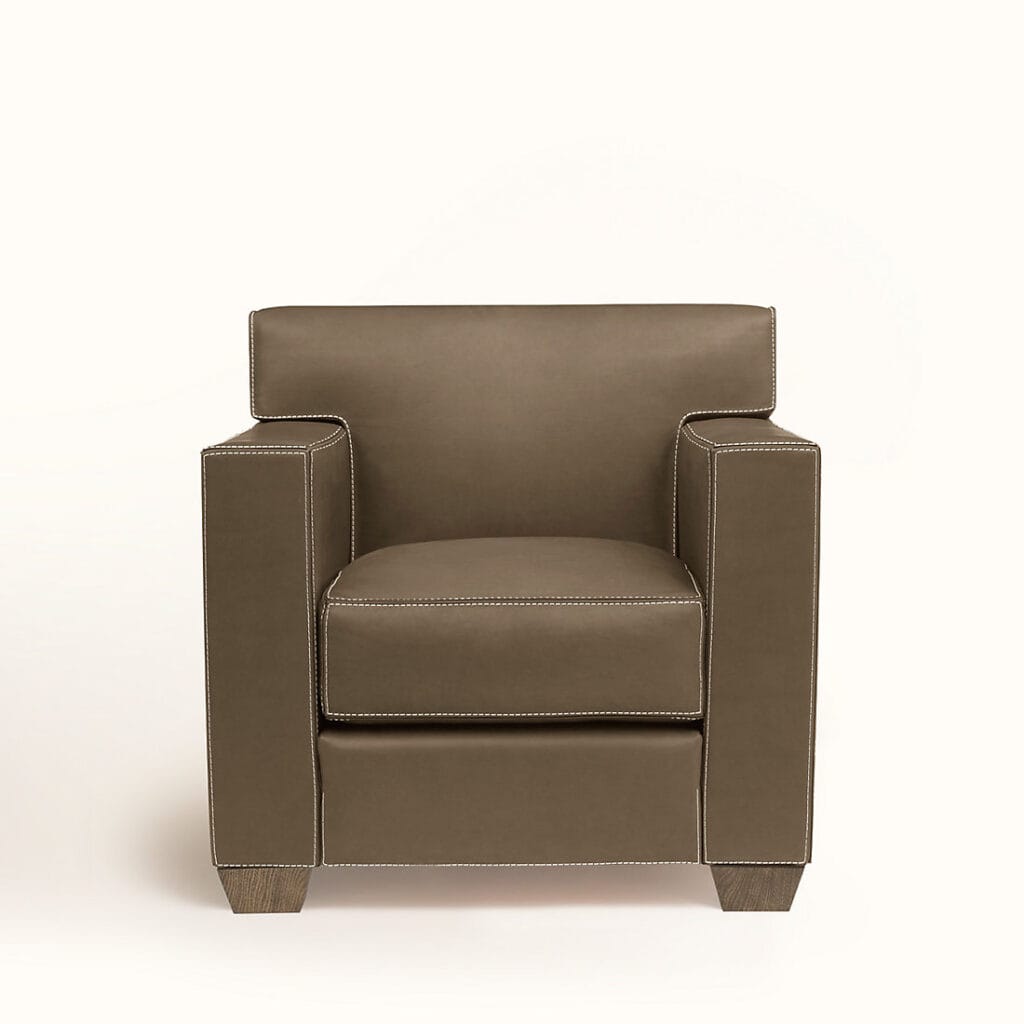
Frank wasn’t just anyone. This elegant man, a champion of refined minimalism, designed interiors for Paris’ elite. But he was searching for something different, something no one else could offer. Then, Eureka! He discovers Hermès saddlery leather.
Picture the moment: Frank running his hands across those exceptional leathers, feeling the perfect grain, inhaling that distinctive scent. He had just found his Holy Grail. This leather, originally crafted for harnesses and saddles, would now cover his boldest creations.
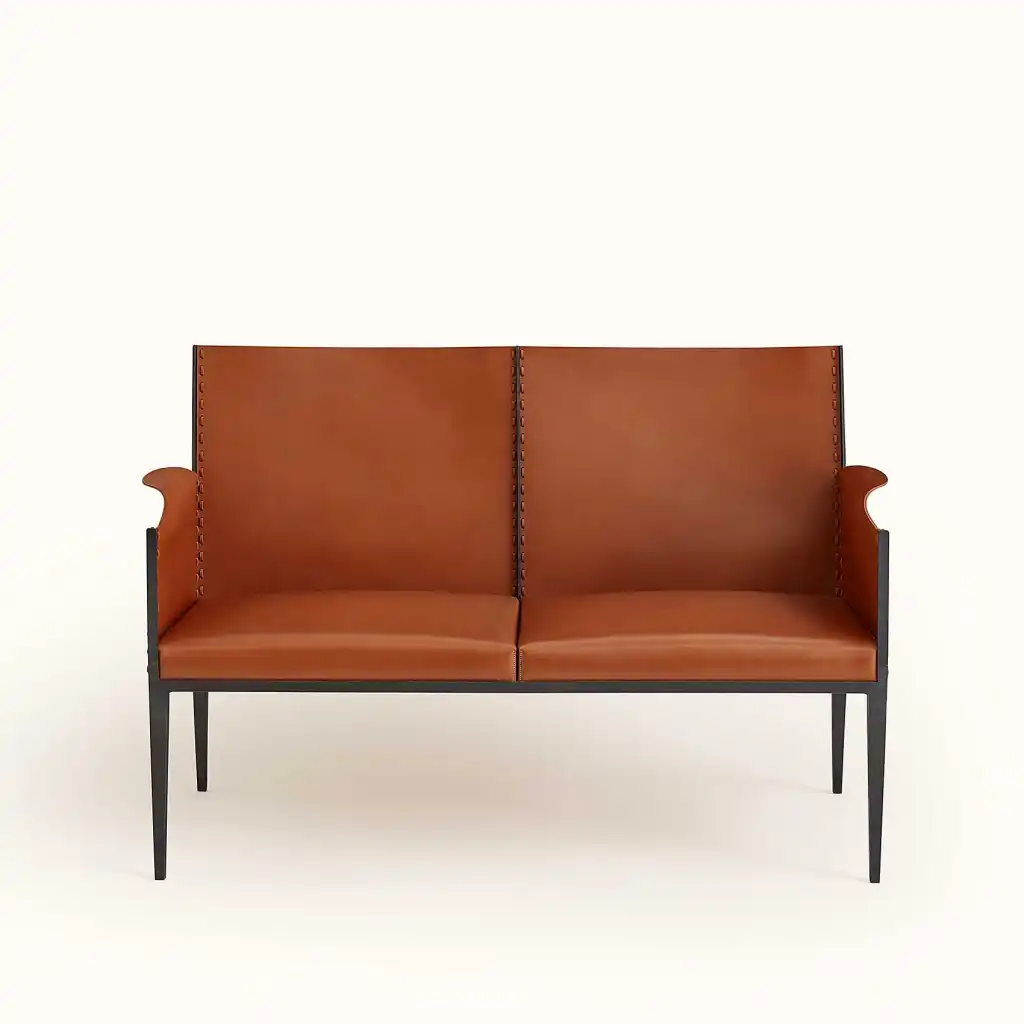
The result? Incredibly elegant pieces where Art Deco geometry meets the sensuality of French leather. These designs would remain timeless for decades — the very definition of enduring design.
Art Deco, Hermès Style: Where Elegance Meets Modernity
This collaboration laid the foundation of what would become Hermès’ furniture DNA:
- Material First: No compromise on quality. Every square inch of leather tells a story of French artisanal excellence.
- Discreet Elegance: Forget flashy excess. Hermès favors silent sophistication — the kind that whispers rather than shouts.
- Timeless Modernity: These designs don’t follow trends; they transcend them. A 1925 Frank/Hermès chair? It would still be a showstopper in a contemporary loft.
The Long Silence (Or How Hermès Quietly Prepared Its Comeback)
70 Years of Creative Gestation
After this fruitful period, Hermès did something almost unheard of in the luxury industry: it went silent. No new furniture collections. No design exhibitions. Just… silence.
But make no mistake — this wasn’t inactivity. It was preparation. While others chased trends, Hermès perfected its leathers, honed its techniques, and cultivated unmatched craftsmanship. Like a fine wine aging in the cellar, the maison was maturing its savoir-faire.
This long-term strategy would pay off. When Hermès returned to the design stage, its legitimacy and expertise would be impossible to ignore.
2011: The Return of the King (Yes, It’s a Triumph)
Milan, Shigeru Ban, and the “Wow” Effect
Milan Furniture Fair, 2011. Design professionals shuffle between booths, jaded by the countless displays. Suddenly, silence: a revolutionary architectural structure captures everyone’s gaze. Japanese architect Shigeru Ban unveils a stunning architectural pavilion made entirely of recycled paper tubes and translucent fabrics. This ephemeral structure, both radical and poetic, becomes the unexpected showcase for Hermès’ return to the design stage.
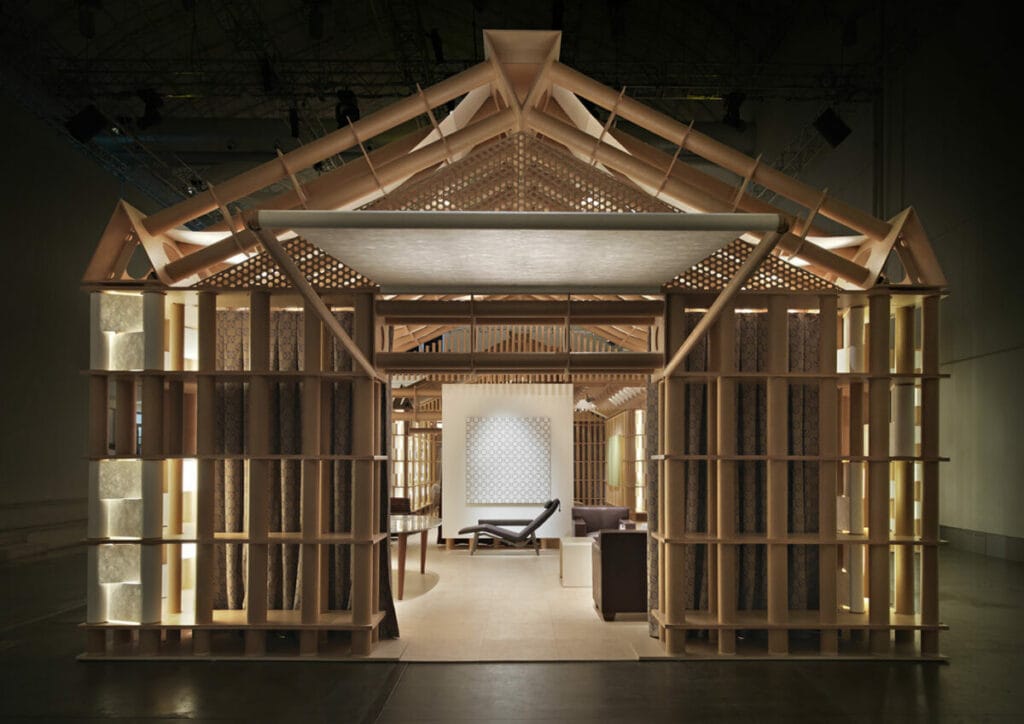
Within this sculptural space, Hermès presents a curated selection of furniture and decorative objects, each embodying the brand’s timeless elegance and handcrafted excellence. The contrast between the raw, recyclable structure and the refined pieces inside creates a powerful dialogue: heritage meets innovation, tradition dances with modernity.
The effect is electrifying. The encounter between Japanese architectural minimalism and French decorative mastery becomes the talk of the town. Hermès’ exhibitions are no longer just highlights of design week — they become calendar-defining moments.
Why such immediate success?
Hermès reinvented the rules of furniture presentation. No more bland showrooms with rows of static pieces. In their place: immersive scenography, where every object plays a role in an emotionally charged narrative.
The Birth of a New Aesthetic
This debut set lasting revolutions in motion:
- Exhibition as Art: Hermès turned commercial presentation into a total aesthetic experience.
- Cross-Disciplinary Dialogue: Architecture, design, and craftsmanship intermingled to create something truly new.
- Narrative Excellence: Every installation told a coherent, emotional, memorable story.
The message was clear: Hermès doesn’t just make furniture — it creates entire worlds.
2014–2023: A Decade of Identity Building
In the years that followed, Hermès carefully developed its own design language. No improvisation, no shortcuts — just a quiet, deliberate construction of a unique vision.
- Noble materials reign supreme: Exceptional leathers, rare woods, patinated metals — each piece showcases a mastery of material that sets Hermès apart.
- Visible craftsmanship: Every stitch, seam, and joint proudly reveals the human hand behind it. Hermès doesn’t hide its process — it honors it.
- Timeless design as a guiding principle: Rather than chase trends, Hermès bets on longevity and aesthetic permanence. The result? Creations that resist time and fashion.
This decade also saw the development of a full ecosystem:
- Smart diversification: Armchairs, tables, lighting, decorative accessories
- Specialized teams: Designers, artisans, and scenographers working hand in hand
- Exceptional showrooms: Permanent spaces in Paris, Milan, and Tokyo
- High-profile collaborations: Partnerships with leading international talents

2024: The Shift
At Milan Design Week 2024, Hermès took a radical turn. Gone was the omnipresent leather. In its place: stone, raw wood, slate, oxidized metals. The focus turned to elemental matter.
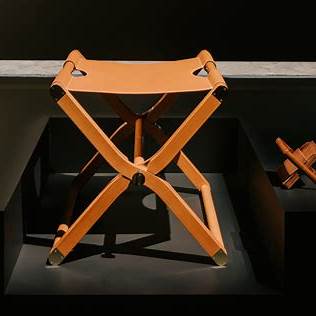
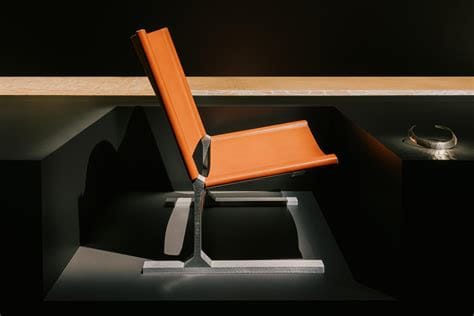
This choice aligned perfectly with contemporary expectations. The new mantra? Quiet luxury. Neutral palettes, tactile surfaces, materials that whisper of time and earth. Hermès wasn’t following a trend — it was elevating it.
The 2024 installation invited sensory immersion:
- Tactile contrast: Rough textures against polished surfaces created surprising tensions
- Dramatic use of materials: Cold stone and warm leather faced off in visual duets
- Sculptural lighting: Low beams caressed every ridge and grain, turning furniture into monuments
The result: a refined statement of calm power. The Hermès ethos translated through geological poetry.
2025: “Drawn to Craft” and the Chromatic Revolution
Charlotte Macaux Perelman & Alexis Fabry: The New Alchemists
Milan Design Week 2025 saw Hermès take another bold step. Moving away from heritage-centric aesthetics, the maison embraced color, light, and emotion.
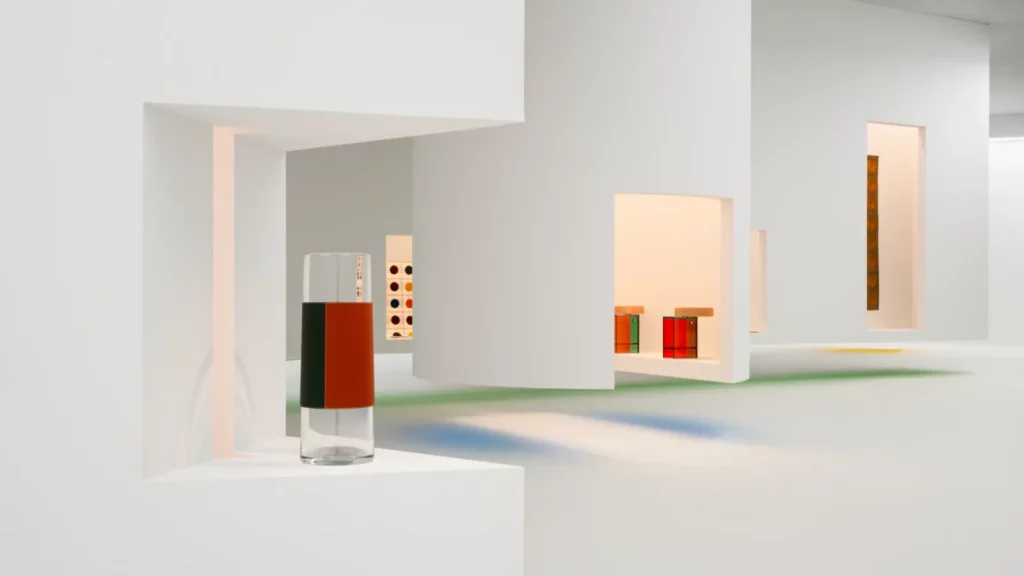
Creative directors Charlotte Macaux Perelman and Alexis Fabry imagined a futuristic installation: a stark white landscape filled with suspended alcoves, each one glowing with vivid halos of light.
Each piece was carefully displayed inside a levitating box — seemingly weightless, undeniably magnetic.
- Radical minimalism: A white stage allowed each object to stand alone and speak for itself
- Color magic: The colorful halos transformed the space into a living cathedral of light
- Poetic levitation: The suspended cubes defied gravity, elevating each creation to a symbol
- Emotional resonance: The experience transcended display — it felt like a spiritual journey
More than just an exhibition, “Drawn to Craft” was a masterclass in sensory storytelling. A temple where craftsmanship met atmosphere. And once again, Hermès didn’t just interpret a trend — it transcended it.
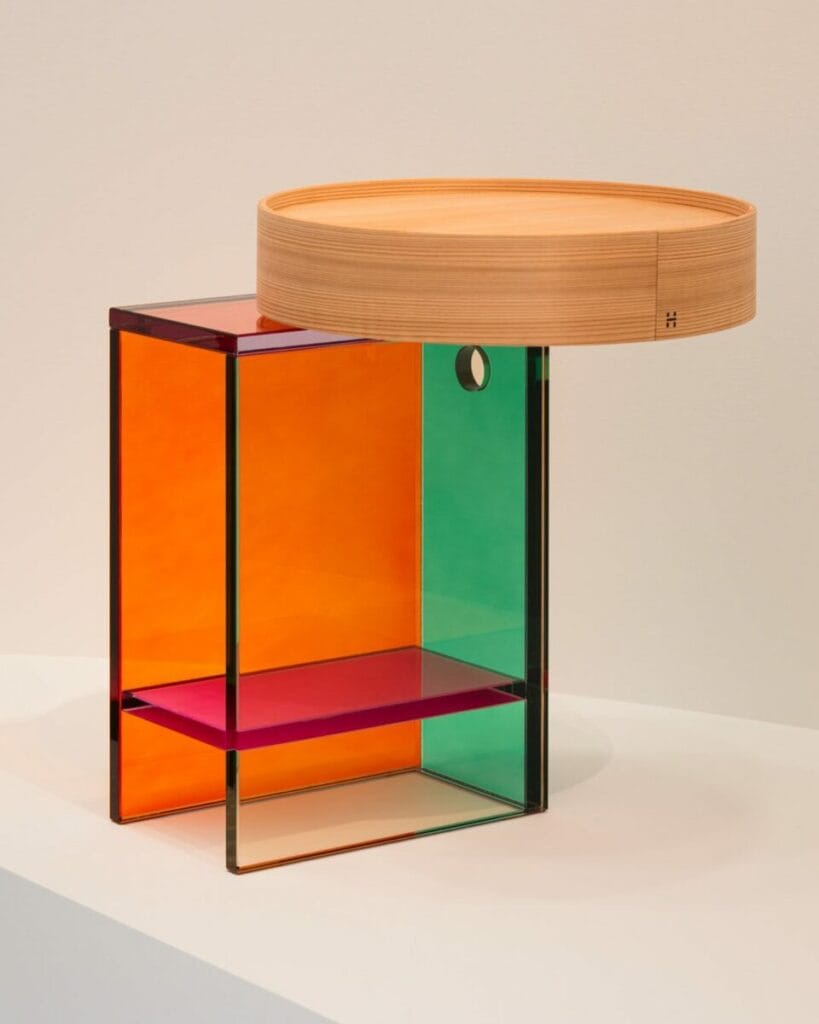
Material Mastery: 2025 and Beyond
This year marked a new leap forward in materials innovation at Hermès:
- Revolutionary leathers: Exclusive treatments deliver entirely new visual and tactile effects.
- Exceptional metals: Patinated brass, sandblasted bronze, brushed steel — all custom-developed for the maison.
- Artistic textiles: Collaborations with elite French weavers result in upholstery unlike anything else on the market.
- Crystal and glass: Master glassmakers co-develop striking decorative elements integrated into the furniture.
All of it driven by one ambition: to push material expression further without compromising authenticity.

Innovation in the Service of Craft
At Hermès, innovation never replaces the hand — it supports it:
- Invisible assembly techniques that make joins disappear
- Surface treatments exclusive to Hermès ateliers
- Ultra-customization for unique collector-grade orders
David vs. Goliath: Hermès in the Luxury Arena
In the competitive world of high-end furniture, Hermès plays a different game:
- Craft vs. Industry: While others scale up, Hermès refines.
- Absolute exclusivity: Limited production, high entry prices, and a tightly curated clientele.
- Holistic lifestyle approach: Buying a Hermès sofa means entering an entire philosophy of living.
Even against the giants — Cassina, Poltrona Frau, B&B Italia — Hermès has advantages they can’t match:
- A narrative legacy spanning nearly two centuries
- Proprietary materials that competitors can’t access
- World-class scenography at global design weeks
- A passionate collector base already loyal to the brand
Forecasting the Future: Sustainability, Expansion, and Influence
Hermès is preparing for the decades ahead with clarity and this is definitely something we love at Hart Design Selection !
Environmental Responsibility
- Full traceability of all materials used
- Circular luxury: Buyback and restoration programs
- Green innovation: Researching sustainable alternatives without compromising quality
- Carbon-conscious logistics throughout the supply chain
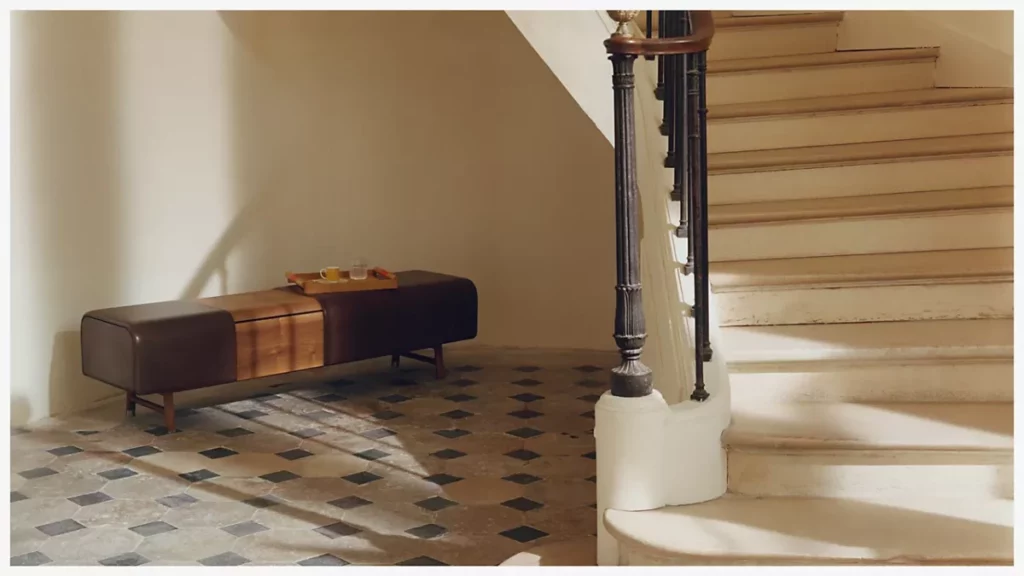
Strategic Growth
- Targeted expansion into emerging markets
- Residential design services for UHNW private clients
- Prestige hospitality projects with global architects
- Integrated lifestyle offerings across categories
Hermès Redefines the Future of Furniture
From the salons of the Roaring Twenties to the glowing cubes of 2025, Hermès has proved that vision and discipline can turn a saddlery into a beacon of design.
Its secret? Relentless focus on craftsmanship, creative boldness, and staying true to its soul.
In 2025, as sofas become the new centerpiece of luxury interiors — blending innovation, beauty, and comfort — Hermès offers its own answer: discreet, refined, and eternal.

Digital entrepreneur and craft artisan, I use my unconventional background to share my vision of luxury design and interior decoration — one enriched by craftsmanship, history, and contemporary creation. Since 2012, I have been working daily in my workshop on the shores of Lake Annecy, creating bespoke interiors for discerning decorators and private clients.

